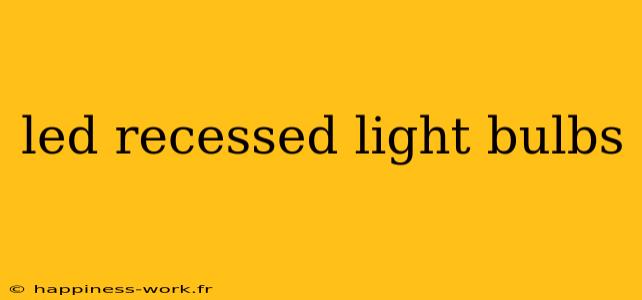In recent years, LED recessed light bulbs have surged in popularity among homeowners and contractors alike. These innovative lighting options not only enhance the aesthetic appeal of any space but also promote energy efficiency and longevity. This article will explore everything you need to know about LED recessed light bulbs, from their benefits to installation tips, providing you with unique insights and practical examples.
What Are LED Recessed Light Bulbs?
LED recessed light bulbs, often referred to as "can lights" or "downlights," are fixtures installed into the ceiling, creating a clean and modern look. Unlike traditional light bulbs, LEDs use semiconductor technology to produce light, resulting in a more energy-efficient and longer-lasting option.
Benefits of LED Recessed Light Bulbs
1. Energy Efficiency
One of the most significant advantages of LED lighting is its energy efficiency. According to the U.S. Department of Energy, LED bulbs use at least 75% less energy than incandescent bulbs and can last up to 25 times longer. This not only reduces your electricity bill but also contributes to a lower carbon footprint.
2. Versatility
LED recessed lights are available in various colors, sizes, and styles, making them suitable for any room. Whether you need warm lighting for a cozy living room or bright white light for a home office, LED recessed lights can adapt to your specific needs.
3. Low Heat Emission
Traditional incandescent bulbs emit a significant amount of heat, which can contribute to increased cooling costs in warmer months. LED bulbs, on the other hand, produce very little heat, making them a safer option, especially in tight spaces.
4. Enhanced Aesthetics
Recessed lighting offers a sleek and modern look, seamlessly blending into ceilings without bulky fixtures. This unobtrusive design draws attention to architectural features or artwork, creating an elegant ambiance.
How to Choose LED Recessed Light Bulbs
When selecting the right LED recessed light bulbs for your space, consider the following factors:
Color Temperature
LEDs come in various color temperatures measured in Kelvin (K). A lower Kelvin (2700K-3000K) provides warm white light, ideal for living spaces. Mid-range (3500K-4100K) works well for kitchens and bathrooms, while a higher Kelvin (5000K-6500K) mimics daylight and is excellent for workspaces.
Lumens
Lumens measure brightness, which is crucial for different areas in your home. A standard 60-watt incandescent bulb emits around 800 lumens. For most living spaces, aim for 700-1600 lumens per fixture, depending on the purpose of the room.
Dimming Compatibility
If you want the flexibility of adjusting the light intensity, ensure the LED bulb you choose is dimmable. Many LED recessed lights are compatible with specific dimmer switches, enabling you to create the desired ambiance.
Installation Tips
While installing LED recessed lights can seem daunting, with the right tools and guidance, it can be a straightforward process. Here are essential steps to consider:
-
Plan Your Layout: Determine where you want your recessed lights installed. Aim for spacing of about 4-6 feet between fixtures for even light distribution.
-
Check the Ceiling Type: Ensure your ceiling can accommodate recessed lights. Standard ceilings typically work well, but you might need special fixtures for sloped or vaulted ceilings.
-
Gather Your Tools: You'll need a drill, a drywall saw, a voltage tester, and wire connectors, among other tools.
-
Turn Off Power: Always switch off the circuit breaker before beginning installation to ensure safety.
-
Cut the Holes: Use a template to mark and cut holes in the ceiling based on your fixture size.
-
Install the Housing: Fit the recessed can into the hole and secure it according to the manufacturer's instructions.
-
Wire It Up: Connect the wires from the fixture to your house wiring. If you are unfamiliar with electrical work, consider hiring a professional.
-
Install the Trim and Bulb: Once everything is wired, attach the trim and insert the LED bulb.
Practical Example
Imagine wanting to update your kitchen with improved lighting. You could install dimmable LED recessed lights above the cooking area for bright light during meal prep, while having softer, warm lights installed over the dining area for a cozy meal atmosphere. This flexibility exemplifies the versatility of LED recessed lights.
Conclusion
LED recessed light bulbs are an excellent choice for energy-efficient, versatile, and aesthetically pleasing lighting solutions. By understanding their benefits, selection criteria, and installation process, homeowners can enhance their living spaces effectively. If you're interested in making the switch to LED, consider consulting with a lighting professional for personalized recommendations tailored to your home.
Attribution: This article expands upon ideas from WikiHow. Original content and authorship of the Q&A come from the collaborative nature of the WikiHow platform, and we encourage readers to explore their resourceful articles for further insights.
